|
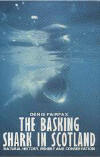
   
The Basking
Shark in Scotland, by Denis Fairfax. Tuckwell Press, East
Lothian, 1998. 206 pp.
This is a splendid overview of Basking Shark natural history,
commercial fisheries, and conservation in Scottish waters.
Meticulously researched and gracefully written, the book features
many reproductions of antiquarian illustrations and rare archival
photographs depicting the morphology and slaughter of these awesome
filter-feeding sharks. My first love is always biology - and there
is certainly plenty of that in this book - but I must admit that I
found the chapters on early Basking Shark researchers and fisheries
fascinating. Even the chapters on traditional and modern Basking
Shark killing technology and processing methods are quite
interesting, in a morbid sort of way. The concluding chapter on
Basking Shark conservation is likewise fascinating, including
details on Monty Priede's first attempt to track a Basker via
satellite. There is an excellent bibliography and a detailed,
well-planned index. For anyone interested in the natural or
commercial history of Basking Sharks, no matter how far beyond
Scottish waters, this book is strongly recommended. [Back to the book list] [Top]
|
|
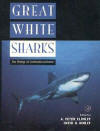
  
Great White
Sharks: the Biology of Carcharodon carcharias, edited by A.
Peter Klimley and David G. Ainley. Academic Press, San Diego, 1996.
517 pp.
Plagued by editorial problems from Day 1, this book is something of
a disappointment. For starters, although there are over 65
contributors and 45 chapters, one or both editors are authors or
co-authors of 12 of them - greatly reducing the volume's overall
diversity of ideas about White Sharks. There is very little
integration among the various chapters and virtually no attempt to
compare or contrast findings about White Sharks with those about
other species. According to a number of paleoichthyologist friends
of mine, the paleontology in this book is generally quite sloppy.
Seven papers focus on the overblown issue of interactions of White
Sharks with humans, events which - by virtue of their relative
rarity - must not be terribly important in the overall biology of
these sharks. I would have much rather seen a comprehensive summary
of the social behavior of White Sharks compared and contrasted with
that of other sharks or a proper discussion of the nature and extent
of the White Shark's role in ocean ecology. I am annoyed that the
publishers opted to save a few pages by collecting all references in
a single, shared bibliography. For researchers and students working
from reprints or photocopies of individual chapters, this creates
bibliographic hassles that could easily have been avoided by the
convention of including cited references after each chapter. Lastly,
the index is bare-bones and all-but useless for locating a specific
bit of information or pulling together related items scattered
throughout the volume. While this volume brings together and reports
many interesting results of recent work on White Sharks, and -
collectively - the various chapters summarize much of our present
knowledge about this celebrated animal, its perspective is far too
White Shark-o-centric to be a really useful springboard to future
work on this or other shark species. Despite my misgivings, this is
the most comprehensive summary of White Shark biology and behavior
thus far produced and is thus, with some reservations, recommended. [Back to the book list] [Top]
|
|
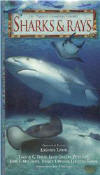
   
Sharks
& Rays, edited by Leighton Taylor. Time-Life Books, San
Francisco, 1997. 288 pp.
Written by a cadre of big-name shark researchers and a renowned
underwater photographer and richly illustrated with gorgeous
full-color photo and diagrams, this book provides one of the best
single-volume overviews of basic elasmobranch biology and our
changing relationship with these fearsome and fascinating fishes.
The bulk of the book is dedicated to brief profiles of some 69
sharks and about 23 batoids, each featuring a color photograph or
painting (often supplemented with a secondary illustration),
identifying features and life history notes. The book also includes
guidelines for planning and undertaking shark and ray encounters as
well as descriptions of and travel logistics for 21 places around
the globe where one can encounter these creatures in the wild. There
is a good directory of resources (books, magazines, websites,
videos, aquaria, museums, universities) and elasmobranch-related
organizations, and a combined index and glossary. the few scientific
errors are relatively minor and do not detract from this book's
overall excellence and utility. Very strongly recommended. [Back to the book list] [Top]
|
|
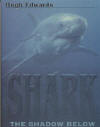
  
Shark: the
Shadow Below, by Hugh Edwards. HarperCollinsPublishers,
Sydney, 1997. 359 pp.
An engaging first-person account of the author's amazing experiences
with White Sharks, Tiger Sharks, Grey Nurse Sharks, Sperm Whales,
and other big marine animals in Australian waters. Edwards, a
long-time professional underwater cinematographer based in Western
Australia, has done some unusual to downright incredible things in
his pursuit of ever-more-spectacular images. Much of the early parts
of this book features detailed accounts of White Shark attacks on
divers and the author's on-going attempts to understand the why's
and wherefore's of these frightening incidents in light of his
personal experiences with White Sharks. Later parts of the book
explore shark diversity, adventures in shark filming, and diving
with Whale Sharks at Ningaloo Reef, Western Australia Then the
material turns back to sharks and the danger they pose to humans,
including comparing sharks to other 'dangerous' creatures,
world-wide patterns of shark attack, and the search for an effective
shark repellent. The book concludes with brief musings about
"Sharing the Planet". Although each chapter is
well-written, overall the book doesn't hand together very well -
reading more like an anthology of separate, self-contained articles
rather than a cohesive, full-length book. It is illustrated with
several inserts of full-color photos that range in quality from
mediocre to quite good, has a brief bibliography, and a bare-bones
index. This book focuses too heavily on shark attacks for my liking
and the science is often a bit soft, but there's no denying that
Edwards knows how to spin a good yarn. Recommended. [Back to the book list] [Top]
|
|
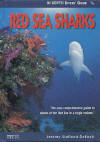
  
Red Sea
Sharks, by Jeremy Stafford-Deitsch. Trident Press, London,
1999. 96 pp.
A compact guide to basic shark biology and behavior followed by a
section on identification and life history of Red Sea sharks, all
illustrated with the author's gorgeous underwater photos and Ian
Fergusson's accurate (if rather lifeless) pen-and-ink drawings.
Drawing on his own extensive first-hand experience, Stafford-Deitsch
provides fascinating insights into aspects of shark behavior and
offers practical advice for divers wishing to interact with sharks
in the wild. A nice, useful little book. Recommended. [Back to the book list] [Top]
|
|

   
The Private Life of Sharks by Michael
Bright. Robson Books, London, 1999. 285 pp.
Bright is the Director of Development for the BBC Natural History
Unit and author of several excellent books, including Animal
Language (1984). Bright avoids re-hashing the same, tired material that fill most
shark books and instead does an admirable job of summarizing the
most important findings in shark biology, life history, and behavior
of the past 10 to 15 years. Includes an insert of exquisite
full-color photographs and fairly extensive, chapter-by-chapter
references to the primary literature. The main weaknesses of this
book are the unappealing text illustrations, consisting of
featureless silhouettes of various sharks, and the vague and
seemingly half-hearted index that reduces this book's value as a
reference. Overall, though, this very worthwhile book presents a
great deal of material not found in most shark books and does so
concisely and well. Strongly recommended. [Back to the book list] [Top]
|
|
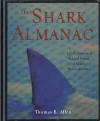

The Shark Almanac by Thomas B. Allen.
Lyons Press, New York, 1999. 274 pp.
This book is a huge disappointment. I expected better from one of
the authors of the 'classic' 1963 book, Shadows in the Sea and the
publisher of Bullock's Underwater Naturalist and Ellis' Search for
the Giant Squid. Lyons Press did a fine job with their part of the
production, designing and manufacturing an attractively laid-out,
well manufactured book (nice reproductions of classic Bigelow &
Schroeder illustrations). Thanks to Lyons' efforts, the book looks as
though it should be useful. Alas, Allen's sloppily researched text
is not worthy of such production values. The fundamental nature and
sheer number of scientific errors (I stopped counting by the time I
got to 200), combined with severely dated text that is often a mere
re-hashing of material from Shadows in the Sea, reduce this book's
value as a reference to almost nil. Allen's attempts at up-dating
the material seem limited to hap-hazard dipping into the commonest,
most easily available sources (IGFA and ISAF) and clumsily throwing a few newer
factoids together with moldering bits from his previous shark book.
The result is a hopeless pastiche of somewhat dated material and
thoroughly discredited leftovers from half a century ago. I cannot
recommend this book. [Back to the book list] [Top]
|
|
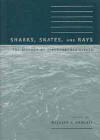
    
Sharks, Skates, and Rays edited by
William C. Hamlett. Johns Hopkins, Baltimore, 1999. 515 pp.
Tons of technical fun, this book is an absolute marvel. In the
finest and most venerable traditions of 'old school' comparative
anatomy and physiology, it brings together masterful summaries of
selected topics in elasmobranch functional morphology, including the
integumentary, musculoskeletal, digestive, circulatory, urogenital,
sensory, and nervous systems. Each chapter is written by one or more
acknowledged pioneers and/or leaders in the discipline covered and
features extensive references to both classical and current primary
literature. The many text figures, borrowed liberally from the
scientific literature, are crisp and clear. The index is well
organized and detailed, enhancing this book's value as a reference.
This book is an 'instant classic', sure to be a standard work for
many years, and is strongly recommended for anyone working on or
having a scholarly interest in elasmobranch functional morphology. [Back to the book list] [Top]
|
|

   
Sharks and Rays of the World by Doug
Perrine. Voyageur Press, Stillwater, 1999. 132pp.
The author of this book is a very talented underwater photographer
and the manager of Innerspace Visions, one of the largest stock
photo agencies specializing in underwater images. It is therefore
not surprising that this book is filled with gorgeous, full-color
photographs of sharks and rays in the wild. What is a little
surprising is how good the text is in what could easily have been
just another pretty picture book. But Perrine is also a trained
marine biologist and a fine and observant marine naturalist. He has
done a commendable job reviewing the basics of elasmobranch
evolution, classification, anatomy, physiology, sensory biology,
feeding and reproductive biology, then goes beyond the usual
material by including fresh insights from many of today's foremost
shark and ray researchers. Perrine also covers well the increasingly
worrisome issue of "human attack" against sharks, bringing
a much-needed scientific perspective to shark conservation. Includes
a table summarizing some of the world's best places to dive with
sharks and rays and a pretty good index. Strongly recommended. [Back to the book list] [Top]
|
|
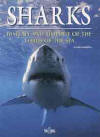
  
Sharks by Angelo Mojetta. Swan Hill,
Shrewsbury, 1997. 167 pp.
Crammed with gorgeous full-color photos and wonderful, mostly
full-color anatomical illustrations, this book is a visual feast. The
images and captions are so numerous, in fact, that it's sometimes
difficult to follow the main text meandering among them. And that's
a shame. The author is one of the most respected ichthyologists
working in the Mediterranean and has packed an astonishing amount of
good, solid information into a very compact space. The text is
nicely written and covers shark evolution, diversity, anatomy,
sensory biology, feeding, reproduction, ecology and behavior.
Mojetta covers all this material exceptionally well - with the
exception of the evolution section, which is severely dated. Also,
numerous sharks depicted in photographs are misidentified, but that
fault probably does not lie with the author. No index. Except for
these relatively few problems, the book is generally accurate,
up-to-date, and covers shark anatomy particularly well. Recommended. [Back to the book list] [Top]
|
|
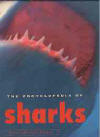
 
The Encyclopedia of Sharks by Steve and
Jane Parker. Firefly, Buffalo, 1999. 192 pp.
This is a mediocre shark book with exceptional full-color
illustrations and an attractive lay-out. Both authors have some
biological training but exhibit no real expertise about sharks. As a
result, the book covers a great breadth of material very
superficially and includes numerous errors of scientific fact. Many
of these errors seem to result from the authors' making assumptions
about sharks based on a basic understanding of biology.
Unfortunately, sharks break or warp so many principles of biological
common-sense, one can take very little for granted about them.
Several of the sharks depicted in photographs are misidentified and
the captions perpetrate further errors of scientific fact. Many of
these problems could have been easily avoided by the simple
expedience of asking one or more shark researchers to vet the
manuscript. Don't get me wrong: parts of the book are pretty good.
But with more thorough research or a bit of humility on the part of
the authors, it could have been much better. An okay read - but if
you miss this one, you're not missing much. [Back to the book list] [Top]
|
|
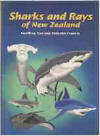    
Sharks and Rays of New Zealand by
Geoffrey Cox and Malcolm Francis. Canterbury University,
Christchurch, 1997. 68 pp.
New Zealand's cartilaginous fish fauna is remarkably diverse,
including many species that also range far from her shores. This
delightful little book features very good full-color paintings by
Cox, whose original illustrations are attractive, informative, and
quite accurate. Cox is one of New Zealand's best-known natural
history writers and illustrators. The text - though brief - covers
shark evolution, selected aspects of biology and behavior, attacks
on humans and human attacks on sharks, role on Maori and Pacific
island mythology, fishing, tagging and conservation, and features an
illustrated catalogue of all known Kiwi chondrichthyans. Francis is
currently New Zealand's premier shark researcher; undoubtedly, the
uniformly accurate and up-to-date text owes much to his involvement.
Together, Cox and Francis have produced a fine regional guide to
chondrichthyans of the New Zealand region and a good introduction to
these fishes in general. Strongly recommended.
[Back to the book list] [Top]
|
|
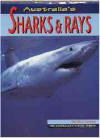
   
Australia's
Sharks & Rays by Neville Coleman. National, Frenchs
Forest, 1996. 63pp.
This little book is filled with stunning full-color photographs of
Australian elasmobranchs - including several rare species -in their
natural habitat. Many of the photos were taken by Coleman (who is
curator of the Australasian Marine Photographic Index) and other of
the region's top underwater photographers. What impresses me most,
however, is Coleman's text, which features many of his own field
observations of Australian sharks and rays, including notes on such
fundamental but tough-to-learn aspects of natural history as habitat
preference, breeding season, and feeding behavior. Strongly
recommended. [Back to the book list] [Top]
|
|
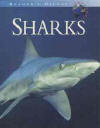
   
Sharks
edited by Reader's Digest. Reader's Digest Association,
Pleasantville, 1998. 159 pp.
At first blush, this colorful, photo- and illustration-rich, thin
volume looks like a mere kids' book. But its pretty diagrams and use
of simple language are highly deceptive. The book's contributing
authors are among the biggest names in current shark research,
including Leonard Compagno, Kim Holland, John McCosker, and Colin
Simpendorfer. This is one of those rare cases where the material
rises far above the apparent limitations of the simple, easily
accessible language. I credit the contributing authors' formidable
collective expertise as well as the skillful editing of Reader's
Digest staff. It is downright astonishing how much scientifically
rock-solid, up-to-the-minute information is expressed with economy,
elegance, and style. As a writer who is always searching for new
ways to communicate serious science with as broad an audience as I
can, I studied this book very carefully to better understand how the
authors and editors made it all work so beautifully. This is
gorgeous, informative book and a model of science exposition for
children and adults alike. Strongly recommended. [Back to the book list] [Top]
|
|
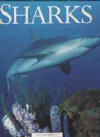
   
Sharks
Second Edition, edited by John Stevens. Weldon Owen, Sydney, 1999.
240 pp.
This is a revised and up-dated edition of one of the 1980's best
popular shark books. The glossy paper and library binding of the
first edition has been replaced with more economical non-glossy
paper and less durable binding. Most of the chapters from the first
edition have been reprinted without significant change, except for
two chapters on shark attacks. The five shark attack chapters (same
number as the first edition and still too numerous for my tastes)
have been euphemistically re-titled as 'shark encounter' chapters.
Two new chapters have been added, one on 'Conserving Sharks' by
Leonard Compagno and the other on 'Observing Sharks' by Kevin Deacon
and Leighton Taylor (recycled from the 'Encounters with Sharks &
Rays' chapter from the Nature Company Guide Sharks and Rays).
Also includes a fairly comprehensive 'Resource Guide', listing books
and other sources for further information. Overall, this is a very
fine and useful book that is sufficiently different from the first
edition to warrant purchasing. And if you don't have the first
edition, this book is strongly recommended. [Back to the book list] [Top]
|
|
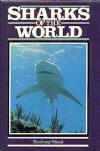
   
Sharks of the
World by Rodney Steel. Facts on File, New York, 1986.
192 pp.
Re-released with a new cover (sorry, the old cover is shown here)
and soft-bound, this book is still a terrific source of information
on shark biology, diversity, and evolution. Although the shark
attack accounts are grossly overwritten, the author - a vertebrate
paleontologist - does an excellent job reviewing in considerable
detail shark anatomy and physiology, includes a fascinating account
of Paleozoic sharks, and surveys many of the most interesting and
important extant shark groups. But perhaps my favorite aspect
of the text is the numerous historical tidbits about Bashford Dean,
Samuel Garman, David Star Jordan, and other pioneers in modern shark
biology. The text is enhanced by scores of excellent
black-and-white illustrations and gorgeous full-color
photographs. A Checklist to living and extinct sharks,
glossary, guide to further reading and index are included.
Strongly recommended. [Back to the book list] [Top]
|
|
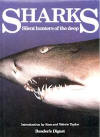
   
Sharks:
Silent Hunters of the Deep edited by Reader's
Digest. Reader's Digest Association, Surry Hills, 1986. 208 pp.
Still available as a trade soft-cover, this is an uneven but
fascinating book. Its contributors include shark researchers,
mostly from Australia but also a few from America. The
introductory chapter on the shark's environment was a good idea, but
too superficial and unintegrated into the rest of the book to be
very useful. However, the chapter on shark sensory biology is
particularly strong, with detailed explanations and terrific
anatomical illustrations. The chapters on shark evolution and
basic shark biology are okay, but nothing special. A chapter
on shark tagging studies in Australia and America and what they have
revealed to date is a nice touch, including a revealing comparison
of variable growth rates. The chapter summarizing humankind's
long and often confused attempt to understand sharks as living
creatures, from ancient Greece through the Age of Exploration, is
simply wonderful. The summary about Baldridge's attempts to
quantify the risk of shark attack is concise and very well
done. As usual, the shark attack case histories are overblown
with lots of bloody pictures - but I must admit the book covers
extremely well the Shark Arm Murder Case, the New Jersey Man-Eater,
and the quirky tale of Sir Brook Watson. There's also a neat
chapter on the "shark callers" of certain remote South
Pacific islands. The chapters on protecting humans from sharks
and human uses of sharks are well done, but I would have liked to
have seen a chapter on protecting sharks from humans. A
reference section includes a terrific table summarizing basic data
on the 344 shark species known at the time, and a brief but
excellent section of common questions and their answers. Shark
game fishing records and an atlas of documented shark attacks round
out the book. There are a General and a Species Index
(including synonyms!) and an incredibly shrunken and tough-to-read
chapter-by-chapter list of sources that could have made an excellent
guide to further literature had it been readily legible without a
magnifying lens. The book is richly illustrated throughout
with hundreds of gorgeous full-color photos, numerous fascinating
archival images, and scores of excellent,
specially-commissioned artwork. Despite its problems, this
book is useful reference and a browser's delight. Very strongly
recommended. [Back to the book list] [Top] |
|
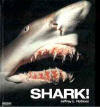
  
SHARK!,
by Jeffrey L.Rotman. 1999. Ipso Facto Publishers, New York.
226 pp.
Let me be brutally blunt here: as a rule, I don't care for
oversize picture-books. They're too big and awkward to curl up
with in a comfy chair and, if they have any text at all, it's
usually hastily-written fluff to serve as a 'frame' around the
pretty pictures. As a scientist and writer, picture books
offend two of my deepest sensibilities. But there's no denying
that this book is absolutely gorgeous. It is, to the best of
my knowledge, the first truly 'fine art' book dedicated to the
subject of sharks. The stunning underwater images of
photographer Rotman are second to none, showing the structural
beauty and diversity of sharks in unparalleled detail. In
these exquisitely reproduced plates, one can see the tiny blood
vessels in the translucent snout of a Little Skate, rare portraits
of several deep-sea sharks, including near-term fetuses of the
appropriately-named Velvet Belly Shark, the huge, ponderous bulk of
Basking and Whale Sharks, the tiny, glass-like teeth and silky
smooth underskin of a Little Skate, the bizarre fleshy beard of a
Spotted Wobbegong, the topological wonders of the Schneiderian folds
inside a Thornback Ray's nares, the awesome splendor of the Great
White, the winged grace of the Manta Ray, the complex metallic
irises, cat-like pupils, and delicately sculpted dermal
denticles of several species of sharks. There are also
fine images of divers and scientists interacting with sharks in the
wild. This book covers an enormous variety of visual scales,
from Lilliputian to Bromdignagian, and — much to the credit of the
photographer and publisher — does so beautifully. This beauty
is purposely shattered at the end of the book with stark images of
sharks as slain monsters and butchered meat. The captions are
brief but interesting, although some of the images beg far more than
the few words provided. Other images — such as the wonderful
full-face view of a Spotted Eagle Ray or the bloody, butchered
carcass of a Salmon Shark need no comment at all. If you enjoy
well-manufactured fine art books featuring technically flawless
photographs exquisitely reproduced, I'd recommend this book.
If beautiful images of sharks make your heart soar, you will be
hard-pressed to find a more stunning collection of images.
Strictly as a researcher, I wouldn't buy this book, simply because
the scientifically revealing images do not-quite warrant the hefty
pricetag. But as a bibliophile and artist who delights in the
sheer beauty of sharks and rays, this book is hard to dislike. [Back to the book list] [Top]
|
|

  
Sharks and Rays of Australia, by Kelvin
Aitken. New Holland Publishers
(Australia), Sydney, 1998. 96 pp.
This lovely little book surveys, in words and pictures, the very rich
chondrichthyan fauna of Australia and addresses some of the most
frequently-asked questions about them. Kelvin Aitken has long been
recognized as one of Australia's most talented and successful underwater
photographers, but this book demonstrates he is also a very knowledgeable
naturalist who expresses his enthusiasm with clarity and a deceptive
accessibility. The resultant book is an unalloyed delight that can be
enjoyed by elasmophiles young and old. Each featured species or question
is illustrated with at least one gorgeous, informative photograph. In
addition, each species' distribution in Australian waters is illustrated
with a range map. This book is not so much a field guide to Australia's
sharks, rays, and chimaeras as it is a celebration of shark diversity and
biological elegance. Since many of the species covered range far from
Australia's shores, this book deserves a very broad audience. Recommended
[Back to the book list] [Top]
|
|

   
Shark Attacks: Their Causes and Avoidance, by
Thomas B. Allen. Lyons Press, New York, 2001. 293 pp.
This is the best popular book on shark attacks to be published in
a long, long time. Too many books on this subject focus on the lurid
and sensational aspects at the expense of exploring why they occur.
This one doesn't. The author, a former newsman by training, does not
rob shark attack case histories of their inherent human drama, but
he also delves into the data of the International Shark Attack File
(ISAF). Allen compares ISAF data with accident statistics from many
other sources to put the risk of shark attack into crisp perspective
and draws on many of the latest findings on shark biology and
behavior. Separate chapters discuss and analyze shark attacks in
Florida and the Mediterranean, California, Hawaii, South Africa,
Australia, rivers and lakes, and in the open sea. There are also
chapters on the most dangerous shark species, new avenues in shark
repellency, and identifying factors that appear to increase one's
risk of being attacked. Advice on what to do if you or your
companion is attacked and an appendix reproducing the ISAF's attack
reporting form round out the book nicely. The text is illustrated
with black-and-white photographs and informative charts and there is
an insert of full-color photos and artwork depicting many of the
most dangerous sharks. An appendix of common and scientific names of
selected sharks, notes on each chapter, a bibliography and index add to the
book's utility as a reference. Although some of the book's biology
is a little soft and I don't agree with some of the theories
espoused therein, for those interested in the straight scoop on
shark attacks, this book is strongly recommended.
[Back to the book list] [Top]
|
|

  
Twelve Days of Terror by Richard G.
Fernicola. Lyons Press, New York,
2001. 330 pp.
This is the most comprehensive — nay, exhaustive — study of the
notorious series of shark attacks that occurred along the New Jersey shore
in July 1916 and which - over half a century later — provided much of the
inspiration for JAWS. The author is widely recognized as the foremost
expert on the so-called "New Jersey Maneater". Fernicola has
been researching these attacks for many years and he has assembled an
astonishing amount of material, ranging from rare archival photographs and
long-lost historical documents to contemporary findings in shark behavior and
the latest shark attack statistics. Although some of the results of
Fernicola's research have been published in an obscure shorter work in 1987 and in a documentary aired in 1990, this book makes the full extent
of his research readily available to a wide readership. The author skillfully
combines biographical details of the victims with historical
context to provide a real understanding to the fear these
attacks inspired nation-wide. Fernicola, a physician by training, brings
his medical expertise to analyzing the injuries of each of the five
victims and draws the most authoritative conclusions thus far reached on
what really happened to those hapless people that fateful summer. Although
the book introduces a fair bit of information about sharks and includes
brief descriptions of selected species, it is not really a shark book but
rather a history book that describes a dramatic period of America's
history that happens to involve sharks. For anyone intrigued by this
infamous series of shark attacks, this book is strongly recommended.
[Back to the book list] [Top]
|
|
     
Sharks & Rays: Elasmobranch Guide to the
World, by Ralf Hennemann.
IKAN - Unterwasserarchiv, Frankfurt, 2001. 304 pp.
This book is a marvel of compactness. It is comprehensive, accurate,
up-to-date, and illustrated with hundreds of gorgeous photographs of
living chondrichthyans in their natural habitats. Part of IKAN's
enormously — and deservedly — successful series of guidebooks, this volume
draws on the publisher's astounding stock of underwater photographs of
sharks, rays, and chimaeras — including many rare and unusual species
never before illustrated in a popular work. The familial taxonomy and
phylogenetic sequence of species covered this book is rather dated and/or
idiosyncratic, but not enough to invalidate its overall accuracy and
usefulness. The font used in the species profiles is rather small and some
may find it difficult to read, but there is no question the text crams a
great deal of factual information in a very small space. The text draws
heavily on Compagno's FAO Catalogue, Sharks of the World (1984), but the
author — a long-time shark enthusiast and ardent fossil shark tooth
collector — has also included much information from the primary
literature as well as his own experience on research vessels. The species
profiles are organized under the following categories: Length,
Distribution, Depth, and General. These encyclopedic entries are augmented
with photo-illustrated essays from prominent shark researchers and
underwater photographers on various aspects of shark biology and behavior.
Indices of common and scientific names and a brief bibliography add to the
book's utility as a reference. This is an absolute must-have book that
belongs in the reference collection of every serious student of
chondrichthyan biology, amateur and professional alike.
[Back to the book list] [Top]
|
|

  
Diving With Sharks and Other Adventure
Dives, by Jack Jackson. New
Holland Publishers, London, 2000. 160 pp.
A practical guide to diving's greatest adventures, drawing heavily on
the author's personal experiences. Jackson is a self-styled, modern-day
adventurer who has enjoyed very broad and varied diving experiences. The
author shares techniques and logistical tips for diving with sharks, dolphins, sea turtles, stingrays as well as wreck
diving, diving in currents, in caves, and under ice. Reading this book is
no substitute for proper training in how to participate in these hazardous
activities, but it can certainly provide much inspiration and sound advice
on when and where to pursue adventure diving once properly trained. The
book is illustrated throughout with full-color photographs — many by
Jackson — as well as informative illustrations and diagrams. I am not
qualified to judge the technical merits of much of the more 'extreme' form
of diving (such as caving and under Antarctic ice), but the advice on
diving with sharks and other large creatures is very sound and clearly
based on long personal experience. The book concludes with a directory of
how to pursue the dives described in the text, including when
and where to go and each dive's recommended proficiency rating. Overall,
this book provides both inspiration and practical advice on some of the
greatest adventures to be had in diving. Recommended.
[Back to the book list] [Top]
|
|

   
Sharks of Florida, the Bahamas, the Caribbean, the Gulf of
Mexico, by
Jeremy Stafford-Deitsch. Trident Press, London, 2000. 95 pp.
Another beautiful and useful regional shark guide from underwater
photographer / naturalist Jeremy Stafford-Deitsch, author of Red Sea Sharks
(also from Trident Press). As with that volume, this book features
gorgeous full-color photos of sharks in their natural habitat — many
taken by the author — and accurate pen-and-ink diagnostic drawings by Ian
Fergusson. After introductory chapters on basic shark biology are sections
on diving with, feeding, and photographing sharks — complete with diving
safety and eco-friendly shark feeding guidelines. The second half of the
book features profiles of the 17 shark species most likely to be
encountered by divers in the region covered. Each species profile
includes: Identification, Distribution, Size, Habitat, Diet, and Comments
as well as a range map and a danger rating. Although intended primarily as
a guide for divers, this is a fine introduction to basic shark biology and
the natural history of sharks in the region covered. Strongly recommended.
[Back to the book list] [Top]
|
|
To Purchase
Any of These Books:
Please contact your local, Independent
Bookseller about Special Ordering
the book(s) you want. Independent Booksellers are the
life's blood that keeps publishers and authors in Business;
they need and deserve your support.
Otherwise, try:
Natural History Book Services
Amazon.com
Barnes
and Noble
|
|
If You'd Like One of Your Books
Reviewed Here:
Publishers who would like one of their books reviewed here are
invited to contact
R. Aidan Martin directly to arrange for a review copy. The only
condition is that Aidan be free to express his honest, unadulterated
opinion about any book submitted for review. |
























